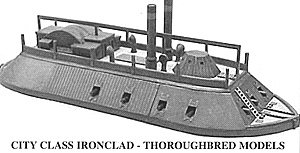Scale of battle can also be broken down in terms of location. If small-scale battles with only a few ships are the goal, it must be decided whether to do river, harbor and fort actions, or high-seas actions as there were generally different types of vessels involved.
The answer to the question concerning scale of miniatures should follow in the wake of those answers from the first part, and will most likely be influenced by availability and available funds. There are several popular scales available with 1/1200 and 1/600 probably being the most played scales. Also available is some 25mm, 15mm, and 10mm. The reference to a scale is read as a size ratio, or also as a measurement, which is more easily transcribed. If an actual vessel was 1200 feet long, a model in 1/1200 scale would be one foot long. This same ratio can also be computed as 1 inch equals 100 feet of the actual vessel. In 1/1200 scale the CSS Virginia (approx.. 270 feet long) would be a little over 2 and a half inches long. In the case of 15mm and 10mm, the scale refers mainly to the height of the figures or crew with the vessel size and fittings matching closely to the figures. A 10mm scale model of the CSS Virginia could be as large as 13 inches long.
There have been a host of rules written for the ACW naval period over the years. Some are available such as Smoke on The Water by Jason Gorringe & Simon Thomas Published by Canis Publishing Available from Langton Miniatures; Iron and Fire by David Manley, Stars, Bars & Tars by Ben King, Run the Guns by Joel Gregory, Hammering Iron II, and Age of Iron by Leo Walsh of Tactical Conflict Systems (probably the largest selling set over the years) for 1/1200.
Author
BRENT NOSWORTHY is an independent scholar whose two previous books on military history, The Anatomy of Victory: Battle Tactics 1689-1763 and With Musket, Sword and Cannon: Battle Tactics of Napoleon and His Enemies, are widely considered classics in their field. His latest book, The Bloody Crucible of Courage - Fighting Methods and Combat Experience of the Civil War is now in print. See Courier review in the Reviewing Stand of this issue for availablity. - ED
Ironclads Their Development and Use During the Civil War
 As with most historical periods, wargamers interested in trying some ACW naval actions as related in Brent’s article must first ask themselves a few key questions. The first two relate to scale - what scale of battle is desired and what scale of miniatures is most appropriate. By scale of battle it is meant what type of action is going to be the concentration; large fleet actions of which there were few during the civil war, or will only a few ships do initially to refight some small combat actions. Questions regarding scale of battle should also be addressed such as some of the following:
As with most historical periods, wargamers interested in trying some ACW naval actions as related in Brent’s article must first ask themselves a few key questions. The first two relate to scale - what scale of battle is desired and what scale of miniatures is most appropriate. By scale of battle it is meant what type of action is going to be the concentration; large fleet actions of which there were few during the civil war, or will only a few ships do initially to refight some small combat actions. Questions regarding scale of battle should also be addressed such as some of the following:
Introduction and Background
The Monitor
The C.S.S. Virginia
The C.S.S. Virginia versus the U.S.S. Monitor
The Attack of Fort Henry and Fort Donelson
Gaming ACW Naval Actions
Back to Table of Contents -- Courier # 89
To Courier List of Issues
To MagWeb Master Magazine List
© Copyright 2003 by The Courier Publishing Company.
This article appears in MagWeb.com (Magazine Web) on the Internet World Wide Web.
Other articles from military history and related magazines are available at http://www.magweb.com